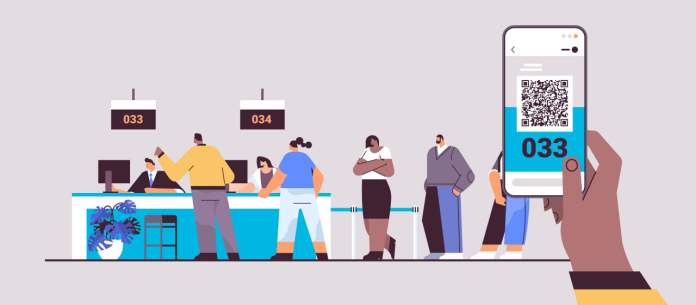Waiting in line is one of the biggest frustrations for customers, whether at a busy bank, a retail store during the holiday rush, or a healthcare facility. Studies show that nearly 70% of customers are less likely to return to a business after experiencing long wait times. This statistic alone highlights the importance of managing queues effectively. Implementing the best queue management system can turn these wait times into a positive experience, transforming how customers perceive your service.
An effective queue management software reduces wait times and improves overall customer satisfaction. By organizing customer flow, providing accurate wait time updates, and allowing for remote queuing, businesses can create a smoother, more efficient experience. Understanding how the right system impacts customer satisfaction is crucial for any organization aiming to deliver top-notch service.
Why Queue Management Matters for Customer Satisfaction
Customer satisfaction is directly linked to the amount of time customers spend waiting and how their wait time is managed. If the process is disorganized, customers will likely leave with a negative impression, regardless of the quality of service they receive afterward. Here’s how the right queue management software addresses these pain points:
- Minimizes Perceived Wait Time: Research indicates that when customers are given an accurate estimate of their wait time, their perception of waiting changes significantly. Even if the wait time doesn’t decrease, transparency helps reduce anxiety and frustration.
- Offers Remote Queuing Options: With a modern queue management system, customers can join a queue remotely through their smartphones or via an online portal. This flexibility allows them to wait from a location of their choice, turning idle waiting time into productive time.
- Enhances Customer Engagement: Advanced queue systems provide real-time updates, estimated service times, and event notifications, keeping customers informed and engaged throughout the process.
- Improves Service Efficiency: When queues are managed efficiently, service staff can focus on delivering quality service instead of handling crowded waiting areas. This structured approach boosts productivity and ensures that customers receive timely attention.
Key Features of the Best Queue Management System
To truly keep customers happy, businesses must choose a system that addresses their unique needs. Here are some of the key features to look for in the best queue management system:
- Real-Time Data and Analytics: Understanding peak times, average service durations, and customer behavior is crucial for optimizing staff allocation and service strategies. Real-time data allows managers to make quick decisions and adjustments, ensuring that queues are managed efficiently even during the busiest times.
- Virtual Queueing and Remote Check-Ins: A system that offers virtual queuing lets customers join the queue without being physically present. This feature is particularly beneficial in settings where customers might prefer to wait outside or be notified via SMS when it’s their turn.
- Digital Signage and Queue Status Updates: Keeping customers informed about their position in the queue and estimated wait times minimizes uncertainty and enhances their overall experience. Digital displays and personalized notifications provide clear, accurate information that reassures customers.
- Appointment Scheduling Integration: Integrating scheduling with queue management creates a seamless experience for businesses that operate by appointment. Customers can book their slot and check in remotely, reducing wait times and ensuring better service organization.
- Multi-Location Management: For organizations with multiple branches or service locations, the ability to manage queues across different sites from a single platform is a game-changer. This ensures consistent service quality and customer experience regardless of location.
How Queue Management Software Improves Customer Loyalty
Investing in the right queue management software goes beyond improving operational efficiency; it directly impacts customer loyalty. Here’s how:
- Positive Experience Leads to Repeat Business: Customers are more likely to return When they have a smooth and predictable experience. This is especially important in sectors like healthcare and banking, where customers expect reliability and organization.
- Reduces the Risk of Queue Abandonment: Long, unmanaged queues can drive customers to leave before receiving service. Implementing a system that reduces wait times and keeps customers informed decreases the chances of losing business due to queue abandonment.
- Provides a Competitive Advantage: A well-managed queue creates a more favorable perception of your business. In industries where customer experience is a key differentiator, having a robust queue management system sets your business apart from competitors equine care.
Measuring the Impact of the Right Queue Management System
To gauge the effectiveness of your queue management software, consider tracking these key performance indicators (KPIs):
- Average Wait Time: Measure how long customers wait to join the queue until they are served. Shorter wait times indicate an efficient system and a smoother service process.
- Customer Satisfaction Scores: Use surveys and feedback tools to assess customers’ feelings about their experience. A well-implemented system should result in higher satisfaction ratings.
- Queue Abandonment Rates: Track the number of customers who leave before receiving service. A drop in abandonment rates signifies that customers are willing to wait longer due to better management and communication.
- Service Efficiency: Monitor how quickly staff can serve customers and handle requests. Higher efficiency suggests that staff can focus more on service quality rather than managing chaotic queues.
Choosing the Right Solution for Your Business
Selecting the best queue management system depends on your business’s specific requirements. A retail store may prioritize fast checkouts, while a healthcare facility might need a system that integrates appointments and virtual queues. Understanding your business’s unique needs and choosing a flexible, scalable solution is key.
For example, a large multi-branch organization will benefit from a system that offers centralized control and analytics across locations. On the other hand, a small business might focus on customer engagement features and ease of use.
Conclusion
Implementing a sophisticated queue management system is no longer optional for businesses aiming to provide a seamless service experience—it’s essential. Nemo-Q’s queue management software is designed to keep customers informed, reduce wait times, and streamline operations. With a strong focus on flexibility and data-driven insights, our solutions ensure that your business operates at peak efficiency while your customers enjoy a hassle-free experience. Choose Nemo-Q’s system to enhance customer satisfaction and elevate service quality today.







